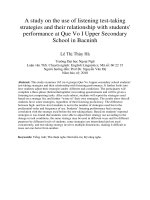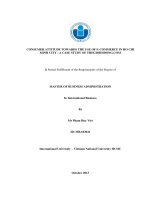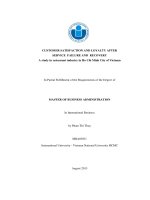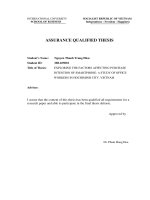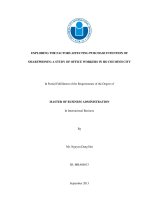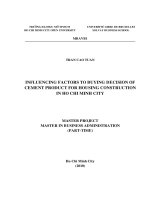A study on bearing capacity of shaft – grouted bored piles and barrettes for high rise in ho chi minh city
Bạn đang xem bản rút gọn của tài liệu. Xem và tải ngay bản đầy đủ của tài liệu tại đây (3.35 MB, 58 trang )
VIETNAM NATIONAL UNIVESITY HANOI
VIETNAM JAPAN UNIVERSITY
PHAM THI THUY DUONG
A STUDY ON BEARING CAPACITY OF
SHAFT – GROUTED BORED PILES AND
BARRETTES FOR HIGH-RISE
IN HO CHI MINH CITY
MAJOR: INFRASTRUCTURE ENGINEERING
CODE: 8900201.04QTD
RESEARCH SUPERVISOR
Dr. NGUYEN TIEN DUNG
MASTER’S THESIS
Hanoi, 2021
TABLE OF CONTENTS
LIST OF TABLES ............................................................................................................... i
LIST OF FIGURES ............................................................................................................. ii
LIST OF ABBREVIATIONS ............................................................................................ iv
CHAPTER 1. INTRODUCTION ........................................................................................ 1
1.1 General Introduction .................................................................................................. 1
1.2 Necessity of Research ................................................................................................ 2
1.3 Objective and Scope of Research ............................................................................... 3
1.3.1 Objectives of the Study........................................................................................3
1.3.2 Scope of the Study ...............................................................................................4
CHAPTER 2. LITERATURE REVIEW ............................................................................ 5
2.1 Principle of the Shaft Grouting Technology .............................................................. 5
2.1.1 Grout Materials and Equipment ..........................................................................5
2.1.2 Construction Procedure .......................................................................................9
2.2 Existing Studies on Shaft-Grouted Piles .................................................................. 12
2.3 Theory for Calculate Bearing Capacity of Drill shaft .............................................. 16
2.3.1 Method of FHWA (FHWA-NHI-10-016) .........................................................16
2.3.2 Method of Vietnam Standard (TCVN10304-2014) ..........................................17
2.4 Theory for Converting Strain to Load ...................................................................... 19
2.5 Linear Regression Analysis...................................................................................... 24
CHAPTER 3. METHODOLOGY ..................................................................................... 25
3.1 Introduction .............................................................................................................. 25
3.2 The Procedure for Determining Correlation between ru and SPT N60; Correlation
between ru and ζ’v .......................................................................................................... 25
3.3 Evaluation of Appropriate Soil Type for Applying Shaft Grouting Technology .... 27
3.4 The Procedure to Comparison of Shaft Grouted Pile and Plain Pile ....................... 30
CHAPTER 4. DATABASE AND ANALYSIS RESULTS .............................................. 31
4.1 Database of Test Piles .............................................................................................. 31
4.1.1 List of Projects ...................................................................................................31
4.1.2 Geological Conditions .......................................................................................33
4.1.3 Test Pair Piles ....................................................................................................35
4.2 The Correlation between ru and SPT N60 ................................................................. 36
4.3 The Correlation between ru and Effective Vertical Stress ζʹv.................................. 38
4.4 Evaluation the Appropriate Soil Type for Applying Shaft Grouting Technology... 39
4.5 Comparison of Shaft Grouted Pile and Plain Pile .................................................... 41
CHAPTER 5. CONCLUSIONS AND RECOMMENDATIONS .................................... 46
5.1 Conclusions .............................................................................................................. 46
5.2 Limitations and Suggestions .................................................................................... 46
REFERENCES .................................................................................................................. 47
ABSTRACT
In recent years, high-rise buildings have been constructed extensively in Ho Chi Minh
City (HCMC) to cope with the increasing demand for living and office spaces. Drilled
shafts (bored piles) for the high-rise buildings in the city, especially in the central
districts along the Saigon river, are often installed up to depths of 70 to 80 m to ensure
the bearing capacity. To reduce many risks and high costs from installing very long
piles, the shaft grouting method has been applied extensively to drilled shafts in the
city to increase the resistance of the shafts or to reduce and shaft length with a
designated resistance. Although the method has been applied extensively, there is still
no comprehensive study on the effectiveness of the shaft grouting method regarding
the geological conditions of the city. It is very necessary to make a comprehensive
study on the effectiveness of the shaft-grouted piles in the city.
The effectiveness of the shaft grouting method was evaluated by comparing the
ultimate (unit) shaft resistance of shaft-grouted piles with that of plain (not grouted)
piles. For this, a database of 34 well-instrumented drilled shafts and barrettes from 12
projects in the city was brought into analytical analyses. Results from the analyses
indicate that the ultimate shaft resistance of shaft-grouted piles in both clayey and
sandy soils in general increases approximately 1.8 times that of the plain piles.
Besides, analyses on suitable soil types indicate that, in general, the stiffer/ denser the
soil, is the better the effectiveness of the method. The soil has SPT-N larger than 10
(stiff clay, very stiff clay, hard clay, medium dense sand, dense sand, and very dense
sand) is suitable to apply the shaft grouting method. It was found that long drilled
shafts for buildings along the Saigon river can be shorted significantly by applying the
shaft grouting method to the lower portion of the piles. The shorter grouted piles not
only satisfy the required resistance but also help the construction cost up to 10%
compared with that for the longer plain ones.
ACKNOWLEDGEMENTS
I would like to express my sincere appreciation to the lecturers of Master of
Infrastructure Engineering Program for their help during my undergraduate at Vietnam
Japan University (VJU).
First of all, I am very grateful to Dr. Nguyen Tien Dung, who guided me to conduct
this thesis for the part one year. He spent a lot of time telling me complicated issues in
geotechnical engineering. Not about knowledge, he also taught me valuable lessons
about the seriousness and carefulness of scientific research. These valuable lessons
will follow me throughout the future study.
I would like to acknowledge the sincere inspiration from Prof. Nguyen Dinh Duc and
Prof. Hironori Kato. Their lectures covered not only specialist knowledge but also the
responsibility and mission of a new generation of Vietnam. I am grateful to Dr. Phan
Le Binh for his support in the last two years since I have studied at Vietnam Japan
University. Thanks to him, I have learned the professional courtesy of Japanese people
as well as Japanese culture. I would also like to acknowledge the staff of Vietnam
Japan University, Mr. Bui Hoang Tan for their help and support. I would also like to
Fecon company as well as other members of Fecon‟s lab, where I had 30 meaningful
days internship at The laboratory. It was very helpful to me.
Finally, I want to spend thank my parents and friends for their unflinching support in
the tough time. Their support, spoken or unspoken, has helped me complete my master
thesis.
LIST OF TABLES
Table 2.1 Summary of typical design parameters following author‟s experience ........ 15
Table 3.1 SPT-N value soil property correlations for (a) granular (sandy) soil ............ 28
Table 4.1 The information of projects in Ho Chi Minh city ........................................ 32
Table 4.2 The information of three test pair piles ......................................................... 35
Table 4.3 The resistance ratio of grouted over not grouted........................................... 37
Table 4.4 The resistance ratio of grouted over not grouted........................................... 39
Table 4.5 The construction cost saving percentage comparison with plain pile and
shaft grouted pile ........................................................................................................... 45
i
LIST OF FIGURES
Figure 1.1 The section and details of tested piles from Gouvenot‟s research ................. 3
Figure 2.1 Detail of Tube a manchette ........................................................................... 6
Figure 2.2 The land view in the grouting process .......................................................... 7
Figure 2.3 Simulate the grout affected area and the grout section cross ......................... 7
Figure 2.4 The grouting diagram CINTAC 15 System – JEANLUTZ ........................... 8
Figure 2.5 The grouting machine .................................................................................... 8
Figure 2.6 The process to construct the shaft grouted bored pile, barrettes pile ............. 9
Figure 2.7 Details of grouting and instrumentation of Saigon and Song Viet project .. 10
Figure 2.8 Cross-section and layout of instrumentation................................................ 10
Figure 2.9 The process of water cracking (a) and shaft grouting (b) ............................ 11
Figure 2.10 Illustration diagram of the grout pipe cross-section, flows paths, the
section of the grouted sample ........................................................................................ 11
Figure 2.11 Variation of gain in load with injection ..................................................... 13
Figure 2.12 The Stocker‟s research result ..................................................................... 13
Figure 2.13 The comparison mobilized friction value between the grouted pile and
plain pile tests in Hong Kong ........................................................................................ 14
Figure 2.14 Summary the mobilized shaft resistances of clayey soil (a) and
sandy soil (b) versus N value......................................................................................... 15
Figure 2.15 Idealized layering for computation of compression resistances ................ 17
Figure 2.16 Frictional model of unit side resistance for drilled shaft ........................... 17
Figure 2.17 The diagram to evaluate p coefficient ...................................................... 19
Figure 2.18 Near pile-head gage level secant stiffness vs measured strain .................. 20
Figure 2.19 Load transfer mechanism for piles, the variation of f(z) with depth.......... 23
Figure 2.20 The mobilized shaft resistance at some strain gauge levels ....................... 23
Figure 3.1 Flow chart to evaluate correlation between ru with N60, ζʹv ........................ 26
Figure 3.2 Illustration plain pile and grouted pile to evaluate shaft resistance increment
....................................................................................................................................... 27
Figure 3.3 Flow chart to evaluate suitable soil type ...................................................... 29
Figure 3.4 Flow chart to compare grouted pile and plain pile ...................................... 31
Figure 4.1 The location of projects in Ho chi minh city .............................................. 31
Figure 4.2 The soil properties and SPT-N value from data of Ho Chi Minhʹs project . 34
Figure 4.3 Illustration of the three test pair piles .......................................................... 36
Figure 4.4 Correlation of ru and N60 for Clayey soil ..................................................... 36
Figure 4.5 Correlation of ru and N60 for Sandy soil ....................................................... 37
Figure 4.6 Correlation of ru and ζʹv for Clayey soil ...................................................... 38
Figure 4.7 Correlation of ru and ζʹv for Sandy soil ....................................................... 38
ii
Figure 4.8 The correlation of the shaft grouting cost to increase one shaft resistance
unit versus Standard penetration test blow count for clayey soil .................................. 40
Figure 4.9 The correlation of the shaft grouting cost to increase one shaft resistance
unit versus Standard penetration test blow count for sandy soil ................................... 41
Figure 4.10 The load – settlement relation chart of pair 1 (TP-01 and TP-02) ............. 42
Figure 4.11 The load – settlement relation chart of pair 2 (TP-04 and TP-05) ............. 42
Figure 4.12 The load – settlement relation chart of pair 3 (TP1-1 and TP3-1) ............. 43
Figure 4.13 The shaft resistance accumulated of pair 1 (TP-01 and TP-02) ................ 44
Figure 4.14 The shaft resistance accumulated of pair 2 (TP-04 and TP-05) ................ 44
Figure 4.15 The shaft resistance accumulated of pair 2 (TP1-1 and TP3-1) ................ 44
iii
LIST OF ABBREVIATIONS
Abase
Ac
Cg
Cs
cu
D
Es
Et
fL
K
L
lc,i
ls,i
N
N60
Ns,i
n
QHL
QSG
QSG
qBN
RB
RS
rs
rs,c
rs,s
ru
zi
p
β
δ
ζ
The cross-sectional area of bearing at the shaft base (m2)
Circumference of pile at strain gage
Shaft grouting cost
Circumference of pile at depth z (m)
Undrained shear strength
Diameter of pile (m)
The secant stiffness modulus of pile material (kPa)
The tangent stiffness modulus of pile material (kPa)
The coefficient depends on the ratio length over diameter
Coefficient of horizontal soil stress
Unit length (m)
Length of pile in clayey soil layer i (m)
Length of pile in sandy soil layer i (m)
The number of blows required to penetrate the soil 30cm from Standard
penetration test
The Corrected N-index for 60% efficient energy
The average SPT index in sandy soil layer i
Number of layers providing side resistance
The load at the pile head (kN)
The load at the strain gauge (kN)
The increment load at the strain gauge (kN)
Nominal unit base resistance (kPa)
Nominal base resistance (kN)
Nominal side resistance (kN)
The unit shaft resistance (kPa)
Nominal unit side resistance of layers i for clay (kPa)
Nominal unit side resistance of layers i for sand (kPa)
The ultimate unit shaft resistance or fully mobilized unit shaft resistance
(kPa)
Thickness of layers i (m)
The coefficient base on the ratio between undrained shear strength and
average effective stress
Side resistance coefficient (beta method)
Effective stress angle pf friction for the soil shaft interface
The strain (mm)
Stress (load divided by cross section area)
iv
ζʹh
ζʹv
B
S
Horizontal effective stress (kPa)
Effective vertical stress (kPa)
Resistance factor for base resistance
Resistance factor for side resistance
v
CHAPTER 1. INTRODUCTION
1.1 General Introduction
The foundation of the high-rise building supports the whole building and plays an
important role in its solidity, sustainability. This is a functional part that directly
transmits the entire load of the building to the ground to create stability, firmness and
safety.
These days, from the development of science and technology, there are many
foundation solutions such as driving and jacking methods; pre-bored precast piling
method; drilled shaft... The high-capacity deep foundation systems which are used
extensively in the world are called under the name drilled shaft or drilled caisson,
bored pile, barrettes piles… For construction, the drill shaft is constructed by digging a
pillar excavation, install reinforcing cage, and then pouring concrete into the
excavation. The method is quite effective for bearing large axial, lateral loads and
overturning forces. In addition, it eliminates the noise and strong ground vibration to
avoid affecting surrounding works. As well as, it is applied for a variety of different
ground conditions. For these reasons, drilled shafts become both the technical and
economic methods for many construction projects.
Drilled shafts are widely applied for highway bridges in seismically active areas
because of the flexural strength of a large diameter column of reinforced concrete as
well as to avoid reducing the bearing capacity of shallow foundations due to surface
soil erosion where installation driving pile might be impossible. The construction
project applied drilled shafts, for instance: Structural support, Slope stabilization,
Earth retention for retaining walls, sound walls, signs or high mast lighting where
simple support for overturning loads.
On the others hand, the increasing urbanization process is leading to an increase in
housing demand. However, the limited land fund in the urban area requires high-rise
building to expand the space vertically. The higher the building, the greater the loaf
transferred to the foundation, which requires a higher capacity of the pile. A simple
1
method to increase the bearing capacity of a pile is increasing the diameter or length of
the pile. But this solution is quite expensive and difficult to control the quality for piles
that are too long. There should be an improving bearing capacity of the drilled shaft
(bored pile and barrettes piles) more effectively and save the cost for the owner.
1.2 Necessity of Research
Based on these limitations of the drilled shaft (bored pile, barrettes pile) many research
was conducted study and find out solutions to enhance the bearing capacity of piles is
that base grouting and shaft grouting. One of the earliest research about shaft grouting
by (Gouvenot and Gabaix, 1975) on 660 mm diameter bored piles showed that “the
injection of cement under pressure enables one to increase by 2.5 times the capacity of
a pile sealed under gravity”. A similar improvement in friction for shaft grouted sand
and clays was reported by (Bruce, 1986), the post-grouting increase in ultimate load of
up to three times in sands and clays on large diameter pile performance. Within this
research, it is impossible to cover all aspects of drilled shaft foundations therefore,
attention is focused on the bearing capacity of shaft grouted bored pile and barrettes
for high rise. A review of published work of (Littlechild et al, 2000) in the load test
program undertaken for Kowloon-Canton Railway Corporation(KCRC) in Hong Kong
demonstrate shaft friction capacities measured for shaft grouted barrettes and piles in
the completely weathered granite and volcanic achieved a two to three-fold increase
when compared with tests without shaft grouting as reported by others…
From previous researches, Shaft grouting technology improves significantly shaft
friction of grouted piles compare with the plain (not grouted) piles. In addition, the
increment ratio depends heavily on geological conditions. Recently, this technology is
applying extensively in many construction projects in Viet Nam by the main
contractors Bachy Soletanche, Bauer Company, Fecon Company, due to the increase
in bearing capacity compared to not grouted piles of the same size. However, there are
still no technical specifications for the design. It is therefore very necessary to make a
comprehensive study on instrumented shaft-grouted pile and barrettes to understand
the behavior and quantitatively increment of shaft resistance of shaft-grouted piles.
2
Figure 1.1 The section and details of tested piles from Gouvenot‟s research
(Source: Gouvenot and Gabaix, 1975)
1.3 Objective and Scope of Research
1.3.1 Objectives of the Study
General Objectives
To evaluate the effectiveness of the shaft grouting method in increasing shaft
resistance of very long bored piles (drilled shafts) and barrettes in Ho Chi Minh and to
suggest appropriate correlations of unit shaft resistance of shaft-grouted piles for
practical design.
Specific Objectives:
1. To determine correlations between ultimate unit shaft resistance (ru) and some
parameters such as the corrected SPT N value (N60) and the effective vertical stress
(ζv) for shaft-grouted and not grouted piles in geological conditions at HCMC.
2. To determine soil types that are appropriate for applying the shaft grouting method
with consideration of the cost-effectiveness.
3. To perform a comparative analysis on-resistance of shorter shaft-grouted piles with
longer not grouted ones under the same diameters and geological conditions.
3
1.3.2 Scope of the Study
To obtain the objectives above, this study focuses on the following:
1. Collect existing data in the literature and data from experiments of the supervisor‟s
research program in Ho Chi Minh city
2. Perform analytical analyses to obtain the expected outcomes.
4
CHAPTER 2. LITERATURE REVIEW
2.1 Principle of the Shaft Grouting Technology
The Shaft Grouting technology is the technology solution with the aim to enhance
shaft resistance along with the pile. The method applied to bored piles and barrettes is
similar to the drilled shaft installation but the new method adds injection high-pressure
grout after pouring concrete into the borehole within 24 hours. The component of the
modern grouting system is 50 mm diameter mild steel “Tube à manchettes” pile or
called grouting tubes, with manchettes (prefabricated holes) spaced at 1m intervals
along with the pile. The grouting tubes are attached to the outside of the steel cage by
using normal tie wire within the zone of the concrete cover. Grouting tubes were
generally arranged around the perimeter of the bored piles and barrettes pile as well as
tubes extended the full depth of the shaft grout zone. Water and grout were injected at
a grouting point by boring/pushing machine.
2.1.1 Grout Materials and Equipment
The mixing for grout must ensure flexibility, good viscosity, homogenous. It consists
of cement, water, and bentonite which was mixed with proportions as follows:
Cement
100 kg
Water
66.6 litres
Bentonite
0.6 kg
Bentocryl 86 150 ml
Daracem 100 400 ml
The grout mixing process uses high-speed mixer machine (at least 1000 rounds per
minute RPM) or drum mixer (at least 150 rpm), it is necessary to pass through a
nominal 1.2 mm sieve to remove lumps. The technical criteria are applied as follows:
5
The strength at 14 and 18 days age of grout cube (1000 cm3) reach at least 18 Mpa and
25 Mpa, respectively.
Viscosity (η) ≤ 40 s
Density (γ) ≥ 1.65 kg/lít
In the steel cage was attached the grouting tubes (Tube A Manchette) were equispaced
around the perimeter of piles. The grouting tubes consist of mild steel tubes 49-60 mm
external diameters covered by rubber sleeve (one-way valve) which is pre-drilled with
the distance between sleeve from 0.5-1.0 m and 1.0 m from the bottom of the pile.
Detail Packer
Figure 2.1 Detail of Tube a manchette
(Source: Nicholson, P.G, 2014)
6
Figure 2.2 The land view in the grouting process
(a)
(b)
Figure 2.3 Simulate the grout affected area and the grout section cross
(Source: Sze and Chan, 2012)
7
Figure 2.4 The grouting diagram CINTAC 15 System – JEANLUTZ
(Source: www.jeanlutzsa.fr/en/6869-2/)
To achieve the required accuracy in recording the grout volume and pressure, an
automatic recorder namely the CINTAC 15 System – JEANLUTZ will be used. This
system is a fully electronic process, which can monitor the grouting pumps. The
grouting pressure is measured with an analog to a numeric pressure transducer which
can measure any flow rate (depending on the diameter of the grouting pipe).
Figure 2.5 The grouting machine
8
2.1.2 Construction Procedure
The construction procedure of shaft grouting pile is similar to the construction
procedure of drill shaft pile, however the construction process of shaft grouting pile
adds two steps: water cracking and shaft grouting. The large diameter bored piles and
barrettes piles were manufactured by excavating ground through a rotary drilling
equipment and rope grab with bentonite and polymer slurry. The bentonite and
polymer slurry was used to support and stabilize the hole walls. The polymer slurry
has litter effect on the shaft resistance of pile on some formations but was found a
noticeable effect on the other formations when compared with bentonite (Lam.C.et al,
2015). After drilling the designed depth, the reinforcing cages were fabricated.
Figure 2.6 The process to construct the shaft grouted bored pile, barrettes pile
Grout tubes will be drilled, which are covered by 1 rubber sleeve per 1.0 meter will
be installed on the steel cage prior to an installation called machette. After cleaning of
drilling hole, rebar cages were installed and concrete was poured. The rubber sleeves
of the grout tubes will be opened with water under pressure from 5 to 24 hours after
concreting of mass pilings and records will be kept in order to show which sleeves
have been successfully “opened” and at what level pressure. Shaft grouting work for
certain piles will be arranged at least 5 days after concreting time of this pile. Figure
2.7 shown for each test pile the location of the strain gauge attached to the reinforcing
cages. For example, each gage level of PTP1-Saigon center‟s barrettes pile contained
two diametrically opposed pairs, gauge A and B, gauge C and D respectively but
because of the rectangular shape of the barrettes, the pair did not cover equal areas of
the barrette cross-section. Each gage level of TP2-Songviet‟s project bored pile
9
contained three gage A, B & C which is located in symmetric figure 2.8. The actual
placement indicates a quasi-symmetry across the barrette and bored pile center for the
gage pairs as placed.
a) Saigon center project
b) Song Viet project
Figure 2.7 Details of grouting and instrumentation of Saigon and Song Viet project
a) Saigon center project
b) Song Viet project
Figure 2.8 Cross-section and layout of instrumentation
10
(a)
(b)
Figure 2.9 The process of water cracking (a) and shaft grouting (b)
Figure 2.10 Illustration diagram of the grout pipe cross-section, flows paths, the
section of the grouted sample
In the water cracking step, the manchette is opened with water under pressure (min
1000 kN/m2- max: 4000 kN/m2) to make flow paths in concrete cover. In the first
place, the double packer was inserted into the grouting tube at the bottom of the tube.
The packer was inflated and water was inflected with high pressure to make the crack
through the concrete cover. This part was carried out within 24 hours after pouring
concrete to avoid concrete reaching hardened concrete. In the second step, the cement
grout was inflected into the grout tube sequentially from the bottom of the tube to the
highest manchette position and make the grout zone into the soil. Each tube will be
grouted by using a grout pump, until the stop with conditions as follow: First, the shaft
grout zone is to be measured from 500 mm above the 1st manchette to 500 mm below
11
the bottom manchette with target grout volume per manchette is 35 litres/m2. If the
target grout volume is not achieved, the side pile will be injected with additional grout
to ensure that the overall minimum average grout takes for mass pilling is greater than
25 liters/m2. The limiting pressure shall be set at 40 bar (4.0 Mpa) or resurgence
(grout flowing back up to the surface) is identified.
2.2 Existing Studies on Shaft-Grouted Piles
There are a variety of replacement piles that are put into holes dug or augured out of
the earth namely: bored piles, barrettes pile, pre-bore H-pile…Most of these pile
capacity is assumption generated from tip bearing friction and rock socket friction
when the tip pile lay on bedrock. However, in some cases the pile lies in the soil and
the pile bearing capacity is generated from friction between soil and pile shaft called
shaft friction. So, the shaft grouting was found to enhance the shaft friction capacity of
these piles. Many research proves that the friction capacity of the grouted pile is large
than 2 to 3 times plain pile (not grouted pile). (Gouvenot and Gabaix, 1975) was first
published in 1975 their finding with six shaft grouted piles D660 mm testing in clay,
sand that grouted pile increase in shaft friction of 2.5 times the capacity of the normal
pile. This result was represented from plot correlation QL/QLo, QL is the ultimate
bearing capacity after pressure grouting, QLo is bearing capacity before grouting.
Between 1975 and 1985, Bruce refers to 300 shaft grouted piles of the Jeddah-Mecca
Expressway. By the way, comparison the grouted pile and not grouted pile through
static load test on the same site, same length. The article presents the advantage of post
grouting both shaft and toe friction that grouting permits increased working load to be
utilized. Similar the research topic, (Stocker, 1983) arranged grouting for toe and shaft
parts. The results showed a permanent increase in shaft friction of 1.5 to 3 times that of
plain piles in granular soil and cohesive soil. However, the limitation of these studies
is that the calculation with the point which did not reach the ultimate statement or
passed the ultimate statement and the SPT-N index is all raw data, leading to
inaccurate results.
12
Figure 2.11 Variation of gain in load with injection
(Source: Gouvenot and Gabaix, 1975)
(a)
Detail of shaft and toe grouting
(b)
Skin friction of cast-in-situ bored pile (at a
settlement of 10mm) and anchors in non-cohesive
soil
Figure 2.12 The Stocker‟s research result
(Source: Stocker, 1983)
A testing program with six piles of large-scale deep foundation carried out for the
Kowloon- Canton Railway Corporation, Hong Kong reported by Littlechild (2000),
showed shaft friction capacity measured for shaft grouted bore piles and barrettes
13
obtained a two to three-fold increase comparison with plain piles for weathered granite
and volcanic. The author use plot to show the correlation between mobilized friction
and average SPT-N to prove his results. As well as, the author highlighted that, the
shaft friction become effective with SPT „N‟ less than 60 in the Hong Kong weathered
materials and increases insignificantly with materials greater than this. The paper from
(Sze and Chan, 2012) conduct back analysis and comparing several historical data to
illustrate the enhanced friction capacity of grouting technology. Through the
experiment, the result showed the correlation between ultimate skin friction and
uncorrected mean blow count of SPT. It can be seen the frictional capacity of the pile
using the shaft grouting technique can be improved by 2 to 3 times of values attained
by the plain pile. Almost the analysis depends on the average SPT-N value or
uncorrected mean blow count of SPT leading to inaccurate results.
Figure 2.13 The comparison mobilized friction value between the grouted pile and
plain pile tests in Hong Kong
(Source: Littlechild, 2000)
14
Table 2.1 Summary of typical design parameters following author‟s experience
(Source: Sze and Chan, 2012)
In Vietnam, shaft grouting is developing extensively especially in Ho Chi Minh city.
However, the technology follows the basic research of (Phan and Pham, 2013). The
research focuses on finding the correlation between shaft resistance (rs) and the mean
SPT-N value to comparing shaft grouted pile and plain pile. The research has been
downside from raw SPT-N value data and the value rs was still increasing (not fully
mobilized- not ultimate) because all test piles did not fail under applied load. An
experimental test reported by (Nguyen et al, 2019) showed the correlation between
ultimate unit shaft resistance (ru) with the SPT-N60 value estimated that the ru value of
grouted pile was two times larger than the plain pile for both sandy and clayey soil.
Besides, the author emphasized that ru values obtained from β-method recommended
applying well in practice.
(a) Clayey soil
(b) Sandy soil
Figure 2.14 Summary the mobilized shaft resistances of clayey soil (a) and
sandy soil (b) versus N value
(Source: Phan and Pham, 2013)
15



